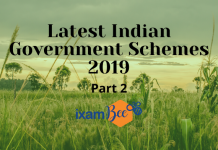The list of India’s vice-presidents is important for any competitive exam. Banking, UPSC, SSC, railways, and other exams are among them. This article has included a list of Vice President of India. You are recommended to read this list before taking the exam to achieve higher scores.
According to the Indian Constitution, the position of Vice-President is the second most powerful authority in our nation. The powers and responsibilities associated with this post are just below the powers of the President of India. Mr. Muppavarapu Venkaiah Naidu, the incumbent vice president of India, ranked number 13 on the list of Indian vice presidents. The vice-presidents of India include all vice-presidents appointed under Article 63 of the Indian Constitution.
The Vice President performs the President’s duties in the case of an emergency, absence, or death. In such cases, the vice-president takes the position of president. Article 65 of the Indian constitution grants him these powers. He has complete authority to make or take any required decisions or acts.
Vice President of India List
Post-independence, till now a total of 13 entities were selected for the role of Vice-President. Dr. Sarvepalli Radhakrishnan served as India’s first vice president. On May 13, 1952, he took the oath of office at Rashtrapati Bhawan. The following is a tabular list of India’s vice presidents from 1950 to 2020:
| S. No. | Vice – President | Took Office | Left Office | President |
| 1 | Dr. Sarvepalli Radhakrishnan | 13 May 1952 | 12 May 1962 | Dr. Rajendra Prasad (First President of India) |
| 2 | Dr. Zakir Hussain | 13 May 1962 | 13 May 1967 | Dr. Sarvepalli Radhakrishnan |
| 3 | Sh. Varahagiri Venkata Giri | 13 May 1967 | 3 May 1969 | Dr. Zakir Hussain |
| 4 | Gopal Swarup Pathak | 1 September 1969 | 1 September 1974 | Sh. Varahagiri Venkata Giri |
| 5 | Basappa Danappa Jatti | 1 September 1974 | 25 July 1977 | Dr. Fakhruddin Ali Ahmed |
| 6 | Justice Muhammad Hidayatullah | 25 August 1977 | 25 July 1982 | Shri Neelam Sanjiva Reddy |
| 7 | Ramaswamy Venkataraman | 25 August 1982 | 25 July 1987 | Giani Zail Singh |
| 8 | Shankar Dayal Sharma | 3 September 1987 | 24 July 1992 | Ramaswamy Venkataraman |
| 9 | Kocheril Raman Narayanan | 21 August 1992 | 24 July 1997 | Shankar Dayal Sharma |
| 10 | Krishan Kant | 21 August 1997 | 27 July 2002 | Kocheril Raman Narayanan |
| 11 | Bhairon Singh Shekhawat | 19 August 2002 | 21 July 2007 | A. P. J. Abdul Kalam |
| 12 | Mohammad Hamid Ansari(Longest serving Vice President and chairman of Rajya Sabha) | 11 August 2007 | 10 August 2017 | Pratibha Patil (2007-2012) Pranab Mujherjee(2012-2017) Ram Nath Kovind (2017) |
| 13 | M Venkaiah Naidu | Aug 06, 2017 | Incumbent | Ram Nath Kovind |
Eligibility Criteria for a Vice President
The candidate must fulfill the below-mentioned eligibility criteria to be on the list of vice presidents of India:
- A citizen of India
- More than 35 years
- He/she should not hold any office of profit under any government or local authority
- He/she must be eligible to be elected as a member of the Rajya Sabha
How is the Vice President of India elected?
The Vice President is elected indirectly by members of both houses of parliament i.e., the Lok Sabha and the Rajya Sabha. The voting is held using a secret ballot. The voting is done with a single transferable vote. Only members of both houses of parliament who have been nominated will vote in the vice-presidential elections.
Any candidate for the position of vice president must deposit a security deposit of Rs. 15,000 with the Reserve Bank of India and the Election Commission of India. The vice-presidential election should be held within two months of the current vice president’s term expiring. If a dispute or controversy occurs during the elections for vice president, it is settled by the Indian Supreme Court. The vice president serves a five-year term. There is no limit to how many times a person can hold the office.
Vice President Oath
The following oath is taken by the selected candidate for the position of vice-president at the swearing-in ceremony. This oath is given under article 69 of the Indian constitution.
The Oath:
“I, [name] do swear in the name of God/solemnly affirm that I will bear true faith and allegiance to the Constitution of India as by law established and that I will faithfully discharge the duty upon which I am about to enter.”
“मैं, [नाम] ईश्वर की शपथ लेता हूँ कि मैं विधि द्वारा स्थापित भारत के संविधान के प्रति सच्ची सत्यनिष्ठा से प्रतिज्ञा करता हूँ, श्रद्धा और निष्ठा रखूँगा तथा जिस पद को मैं ग्रहण करने वाला हूँ उसके कर्तव्यों का श्रद्धापूर्वक निर्वहन करूँगा।”
Conclusion
The Vice President is an important part of the Indian Constitution which is asked in most of the government exams. This article is relevant for the static GK portion of the competitive exams like UPSC, RRB, SSC, RBI Grade B, SEBI Grade A, SBI Clerk, SBI PO etc. Read it thoroughly for the exams and to know the constitution better.
Also Read:
List of Longest Highway in India: Updated 2021
Indian States and Union Territories with their Capitals [Updated List]
Tips and Tricks to Solve Input Output Reasoning Questions
Anti-Terrorism Day 2021: Importance, Significance, and History of May 21
Get Free Online Test Series, GK updates in form of Beepedia, as well as latest updates for Bank PO, Bank Clerk, SSC, RBI, NABARD, and Other Government Jobs.













